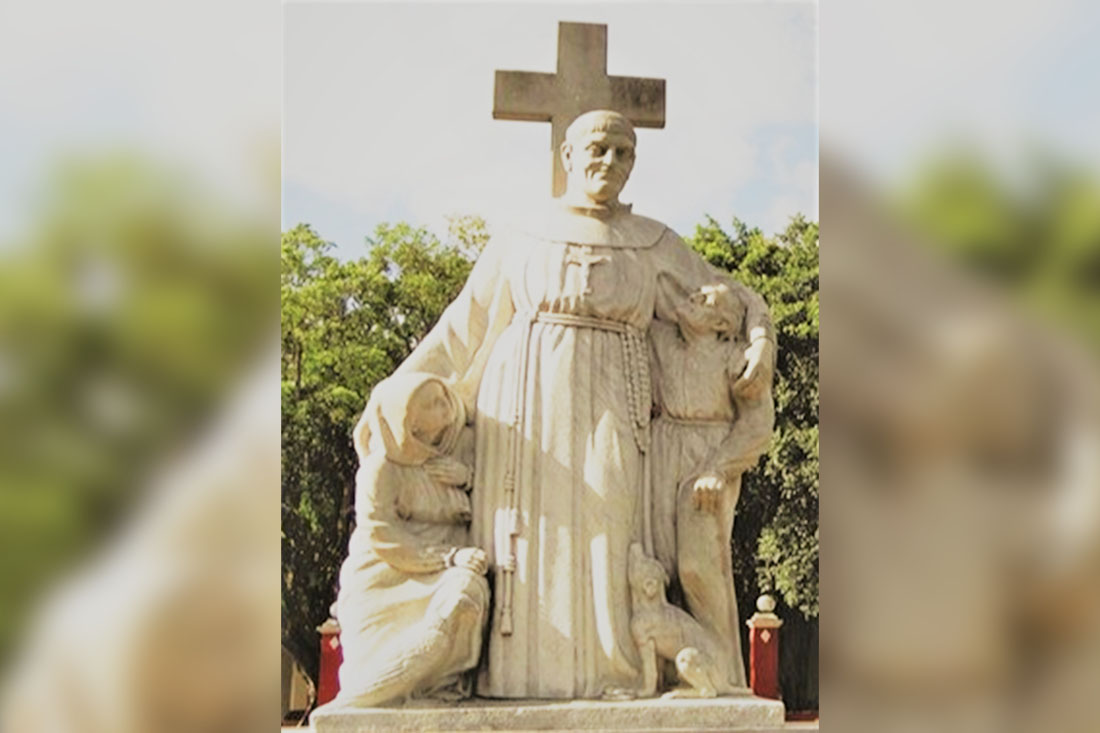The Municipal Music Band broke the silence and the genuine Carrara marble shone instantly, after Father Salvador Basulto, vicar of the Bishopric and chaplain of the nursing home, blessed the sculpture for its prompt unveiling. Precisely, one Mother’s Day, on Sunday May 8th, 1955, the people of Camagüey crowded at 10:00 a.m. in front of the Father Valencia nursing home to participate in the ceremony.
The donations of the people led by the initiative of Mr. Juan Bautista Castellón (Don Pancho), director of the CMJK radio station, and Luis Pichardo Loret de Mola, chief of general information for El Camagüeyano newspaper, made a dream of devotees and grateful for the work come true of the unrivaled work of José de la Cruz Espí, a generous Franciscan benefactor highly honored for his charitable works, credited as Father Valencia, after his place of birth.
Representatives of the San Francisco de Asís order in Havana were invited to the event. The floral offerings were sent by La Orquídea Garden, La Rosa Blanca Garden and Vidal Flower Shop. The Hogaristas School also paid an offering, as well as the José Martí School of Plastic Arts. A boy of only 11 years: Rigoberto Vento, was also the protagonist of the magnanimous act.
The sculptor and his work
Heliodoro Álvarez del Campo was the sculptor in charge of the work. His name is not really part of the highest figures in art. So the biographical data is scarce and they were molded with the stone of this sculptural set that cost a little more than 5 thousand pesos, according to data provided by El Camagüeyano newspaper. The pedestal was financed by the municipal Mayor of Camagüey, Panchito Arredondo.
The set is made up of three human figures and a dog. The central figure is the Father. On the left side is an old man who interconnects his gaze with the face of José de a Cruz Espí and supports his body on a cane. On the other side, there is a seated woman, needy, where her sight is totally devoted to the face of The Benefactor.
The dog symbolically underlines the presence of lepers. The sculptor singled out each character, and the marble stone transmits both the folds of the clothes, the chiaroscuro, the movement, the opportune gesture as well as the soul of the charitable person. On the other hand, the signs of the Franciscan order were represented. The frankly visible habit of the order of San Francisco de Asís, since the Franciscan cord with three knots is shown around its waist, encircling the sackcloth. Denoting the vows of poverty, chastity and obedience. In his neck the cross of Tau and the Christ of San Damián, distinctive symbols of the order.
Who was Father Valencia?
On May 2nd, 1763, José de la Cruz Espí was born in Valencia, Spain. On August 15th, 1777 he stars a life of perpetual consecration. He served the order in Mexico, California, Cuba. He made Puerto Príncipe his destination, he wrote to the priest D. Ceferino Álvarez from Trinidad on October 4th: “I always believed that N.P. Provincial would have remembered the words that V. told me he had given him when he said goodbye, that upon arriving in Havana he would send me to the Puerto Príncipe.”
His work reflected in the sculpture
Gertrudis Gómez de Avellaneda wrote:
“Lepers wandered the streets asking for God’s sake an alms, which not even the most pious people could extend to them without taking their eyes off her disgusting appearance. Those unhappy beings ꟷdangerous to public healthꟷ multiplied day by day; despite perishing in great numbers, crowded into filthy and unknown slums, to which medical science never came to provide them with any relief, and not even religion itself always came to offer them, in their last moments, spiritual aid.
In addition to his charitable, health work with lepers, Camagüey city has in its deepest traces the soul of Father Valencia: The Ursuline monastery-college to illustrate the intelligence and educate the hearts of the maidens. The Women’s Hospital and the Carmen Church. Among other works.
In heritage perspective
The material cultural heritage is strongly linked to historical memory, a tool of cultural identity and reconstruction of the feeling of identity. The commemorative sculptural monument on the transcendent work of Father Valencia is an example of the connection of the historical past, the patrimonial present and the future positioning of values.
Bibliography
Eusebio del Niño Jesús (1926) Compendio biográfico del Padre Valencia, Imp. Seoane y Fernández, La Habana, Cuba.
El Camagüeyano newspaper, 1955
Translated by: Aileen Álvarez García






